Biology:Short-faced bear
| Short-faced bear | |
|---|---|
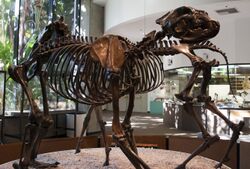
| |
| A. simus from the La Brea tar pits | |
| Scientific classification | |
| Script error: No such module "Taxobox ranks".: | Animalia |
| Script error: No such module "Taxobox ranks".: | Chordata |
| Script error: No such module "Taxobox ranks".: | Mammalia |
| Script error: No such module "Taxobox ranks".: | Carnivora |
| Script error: No such module "Taxobox ranks".: | Ursidae |
| Script error: No such module "Taxobox ranks".: | Tremarctinae |
| Script error: No such module "Taxobox ranks".: | †Arctodus Leidy, 1854 |
| Type species | |
| †Arctodus pristinus Leidy, 1854
| |
| Other species | |
| |
The short-faced bear (Arctodus sp.) is an extinct bear genus that inhabited North America during the Pleistocene epoch from about 1.8 Mya until 11,000 years ago. It was the most common tremarctine bear in North America and many of its fossils have been found in the La Brea tar pits in southern California .[1] There are two recognized species: the lesser short-faced bear (Arctodus pristinus) and the giant short-faced bear (Arctodus simus), with the latter considered to be one of the largest known terrestrial mammalian carnivores that has ever existed. It has been hypothesized that their extinction coincides with the Younger Dryas period of global cooling commencing around 10,900 BC.
Taxonomy
These species appear to have a disproportionately short snout compared to most modern bears, giving them the name "short-faced." This apparent shortness is an illusion caused by the deep snouts and short nasal bones of tremarctine bears compared with ursine bears; Arctodus has a deeper but not a shorter face than most living bears. This characteristic is also shared by the only living tremarctine bear, the spectacled bear.[2] The scientific name of the genus, Arctodus, derives from Greek, and means "bear tooth".
Evolution
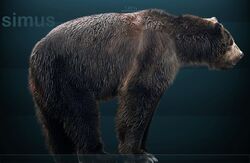
The short-faced bears belong to a group of bears known as the Tremarctinae, which appeared in North America during the earliest parts of the late Miocene epoch in the form of Plionarctos, a genus considered ancestral to Arctodus. During the Great American Interchange that followed the joining of North and South America, tremarctines invaded South America, leading to the evolution of Arctotherium and the modern spectacled bear (Tremarctos ornatus). Although the early history of Arctodus is poorly known, it evidently became widespread in North America by the Kansan age about 800,000 years ago.
Arctodus simus first appeared during the middle Pleistocene in North America, about 800,000 years ago, ranging from Alaska to Mississippi,[3][4] and it became extinct about 11,600 years ago. Its fossils were first found in the Potter Creek Cave, Shasta County, California.[5] Remains of the giant short-faced bear, along with Paleo-Indian artifacts and the remains of the flat-headed peccary, stag moose, and the giant beaver were found in the Sheriden Cave in Wyandot County, Ohio.[6]
A. simus might have been the largest land-dwelling species of Carnivora that ever lived in North America. A giant short-faced bear skeleton has been found in Indiana, unearthed south of Rochester.[7] It has become well known in scientific circles because it was the most nearly complete skeleton of a giant short-faced bear found in America. The original bones are in the Field Museum of Natural History, Chicago.[7]
Arctodus pristinus inhabited more southerly areas, ranging from northern Texas to New Jersey in the east, Aguascalientes, Mexico[8] to the southwest, and with large concentrations in Florida, the oldest from the Santa Fe River 1 site of Gilchrist County, Florida paleontological sites.
Description
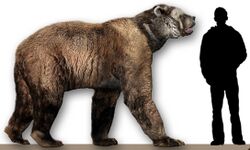
In a recent study, the mass of six A. simus specimens was estimated; one-third of them weighed about 900 kg (1 short ton), the largest 957 kg (2,110 lb), suggesting specimens that big were probably more common than previously thought. There is much variation in adult size among specimens, suggesting that like living bears, Arctodus was both sexually dimorphic (with females smaller than males) and varied in size in different areas (with northern populations larger).[2] A. pristinus was much lighter, estimated at an average weight of 540 kg (1,190 lb).[9] Standing up on the hind legs, A. pristinus stood 2.5–3 m (8–10 ft) tall, and A. simus stood 3.4–3.7 m (11–12 ft) tall with a 4.3-meter (14 ft) vertical arm reach.[10] When walking on all fours, A. simus stood 1.5–1.8 m (5–6 ft) high at the shoulder and would be tall enough to look an adult human in the eye. The largest individuals of A. simus are estimated to have weighed more than 1,200 kg (2,600 lb).[11][12][13] At Riverbluff Cave, Missouri, a series of claw marks up to 4.6 m (15 ft) high have been found along the cave wall indicating short-faced bears up to 3.7 m (12 ft) tall.[14][15]
Diet
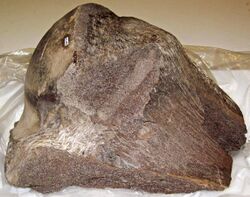
Researchers disagree on the diet of Arctodus. Analysis of bones from Alaska showed high concentrations of nitrogen-15, a stable nitrogen isotope accumulated by meat eaters, with no evidence of ingestion of vegetation. Based on this evidence, A. simus was suggested to have been highly carnivorous and as an adult would have required 16 kg (35.3 lb) of flesh per day to survive.[10][16][17] Others point out that nitrogen-15 bone analysis cannot distinguish between hypercarnivores and omnivores that ate a significant amount of animal matter,[18] that the species would have had a varied diet across its range,[19] and that the features of the skull and teeth match modern omnivorous bears and it was probably an omnivore with northern individuals having a similar diet to Alaskan brown bears.[2]
One proposal for its predatory habits envisages A. simus as a brutish predator that overwhelmed the large mammals of the Pleistocene with its great physical strength. However, some suggest that despite being very large, its limbs were too gracile for such an attack strategy.
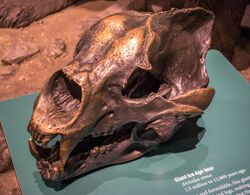
Because its long legs enabled it to run at speeds of 50–70 km/h (30–40 mph), an alternative hypothesis is that it may have hunted by running down Pleistocene herbivores such as wild horses and saiga antelopes, and even prey such as mammoths, an idea that at one time earned it the name "running bear".[20] However, during pursuit of speedy game animals, the bear's sheer physical mass and plantigrade gait would be a handicap; modern brown bears can run at the same speed but quickly tire and cannot keep up a chase for long. Arctodus skeletons do not articulate in a way that would have allowed for quick turns – an ability required of any predator that survives by chasing down agile prey.[10] A 2010 study found that its legs weren't proportionally longer than modern bears would be expected to have, and that bears in general being long-limbed animals is obscured in life by their girth and fur. The study concluded the supposed "long-legged" appearance of the bear is largely an illusion created by the animal's relatively shorter back and torso.[2]
Arctodus moved in a pacing motion like modern bears, making it built more for endurance than for great speed.[10] A. simus, according to these arguments, was ill-equipped to be an active predator, leading some to conclude that it was a kleptoparasite,[10] using its enormous size to intimidate smaller predators, such as dire wolves, saber-tooth cats, American cheetahs and American lions, or chase them from their kills and steal their food. This idea was challenged in a 2013 study of the micro-wear of the teeth of various extant and extinct bears. Specialized scavengers like hyenas show distinctive patterns of molar damage from cracking bones. Based on lack of "bone-cracking" wear in specimens from Rancho La Brea, researchers concluded that Arctodus simus was not a specialized scavenger. Of living bears, this population of A. simus showed the most similar tooth wear patterns to its closest living relative, the spectacled bear, which can have a highly varied from obligate omnivory to being almost purely herbivorous in diet depending on region and seasonal avaliblility.[19] This conclusion was supported by a 2010 study that concluded that the species was neither a super-predator nor a pure scavenger, but an opportunistic omnivore like modern brown bears.[2]
These findings that Arctodus did not significantly differ in dentition or build from modern bears has lead most authors to support the hypothesis that the giant short-faced bear and the cave bear were omnivores, like most modern bears, and the former may have eaten plants depending on availability.[21] Even if Arctodus was omnivorous, it was probably more carnivorous than its closest living relative the spectacled bear, 93–95% of whose diet consists of tough plants because of its mountainous habitat and its diet might more favorably compare to the brown bear.[22]
See also
References
- ↑ Brown, Gary (1996). Great Bear Almanac. p. 340. ISBN 978-1558214743. https://archive.org/details/greatbearalmanac00gary/page/340.
- ↑ 2.0 2.1 2.2 2.3 2.4 Figueirido (2010). "Demythologizing Arctodus simus, the 'short-faced' long-legged and predaceous bear that never was". Journal of Vertebrate Paleontology 30 (1): 262–275. doi:10.1080/02724630903416027.
- ↑ C. S. Churcher, A. V. Morgan, and L. D. Carter. 1993. Arctodus simus from the Alaskan Arctic Slope. Canadian Journal of Earth Sciences 30(5):1007-1013, collected by A. V. Morgan
- ↑ Cassiliano M. L. (1999). "Biostratigraphy of Blancan and Irvingtonian mammals in the Fish Creek-Vallecito Creek section, southern California, and a review of the Blancan-Irvingtonian boundary". Journal of Vertebrate Paleontology 19 (1): 169–186. doi:10.1080/02724634.1999.10011131.
- ↑ Cope E. D. (1879). "The cave bear of California". American Naturalist 13: 791.
- ↑ Brian G. Redmond, PhD., Curator of Archaeology (March 2006). "Before the Western Reserve: An Archaeological History of Northeast Ohio". The Cleveland Museum of Natural History. p. 2. https://www.cmnh.org/CMNH/media/CMNH_Media/C-R%20Docs/BeforeWR.pdf.
- ↑ 7.0 7.1 Willard, S.. "Rochester's Giant Bear Gets Famous". https://www.fultoncountyhistory.org/shirley-willard-writings.
- ↑ I. Ferrusquia-Villafranca. 1978. Bol Univ Nac Aut Mex Inst Geol 101:193-321
- ↑ Sorkin, B. (2006). "Ecomorphology of the giant short-faced bears Agriotherium and Arctodus". Historical Biology 18 (1): 1–20. doi:10.1080/08912960500476366. https://www.academia.edu/9030763.
- ↑ 10.0 10.1 10.2 10.3 10.4 Nancy Sisinyak. "The Biggest Bear ... Ever". Alaska Fish and Wildlife News. http://www.adfg.alaska.gov/index.cfm?adfg=wildlifenews.view_article&articles_id=232&issue_id=41.
- ↑ "Yukon Beringia Interpretive Centre". http://www.beringia.com/research/bear.html.
- ↑ "North American Bear Center". Extinct Short-faced Bear. https://www.bear.org/website/bear-pages/extinct-short-faced-bear.html.
- ↑ Brown, Gary (December 3, 2013). The Bear Almanac, 2nd: A Comprehensive Guide to the Bears of the World. Lyons Press. p. 8. ISBN 978-0762788064. https://books.google.com/books?id=5B1VAgAAQBAJ&pg=PA8.
- ↑ "Bear Claw Marks". Riverbluff Cave - The Official Website. http://www.riverbluffcave.com/gallery/rec_id/104/type/1.
- ↑ "Cave Animals". Riverbluff Cave - The Official Website. http://www.riverbluffcave.com/category/cave_animals.
- ↑ Bocherens, H.; Emslie, S. D.; Billiou, D.; Mariotti A. (1995). "Stable isotopes (13C, 15N) and paleodiet of the giant short-faced bear (Arctodus simus)". C R Acad Sci 320: 779–784. https://www.academia.edu/751564.
- ↑ National Geographic Channel, 16 September 2007, Prehistoric Predators: Short-faced bear,’’ interview with Dr. Paul Matheus
- ↑ "Ecomorphology of the giant short-faced bears Agriotherium and Arctodus" (in en). https://www.researchgate.net/publication/247494638.
- ↑ 19.0 19.1 Donohue, Shelly L.; DeSantis, Larisa R. G.; Schubert, Blaine W.; Ungar, Peter S. (2013). "Was the giant short-faced bear a hyper-scavenger? A new approach to the dietary study of ursids using dental microwear textures". PLOS ONE 8 (10): e77531. doi:10.1371/journal.pone.0077531. PMID 24204860. Bibcode: 2013PLoSO...877531D.
- ↑ US National Park Service paleontologist Greg McDonald.
- ↑ ScienceDaily, 13 April 2009."Prehistoric bears ate everything and anything, just like modern cousins". https://www.sciencedaily.com/releases/2009/04/090408170815.htm.
- ↑ Nowak, Ronald M. (1999). Walker's mammals of the world (Sixth ed.). Baltimore: Johns Hopkins University Press. ISBN 0-8018-5789-9. OCLC 39045218.
Wikidata ☰ Q2626037 entry
